.jpg)
What is Carrot, Gajar?
Carrot have a long, narrow, cylindrical cone shape root, but they are also found in other varieties that may be thick and short in shape, or that are orange, red, purple, yellow, or white in color. The carrot has a sweet flavor and is one of the most popular versatile root vegetables. The carrot has a thick, fleshy, deeply colored root, which grows underground, and feathery green leaves that emerge above ground. Carrot roots have a crunchy texture and a sweet and minty aromatic taste, while the greens are fresh tasting and slightly bitter.
Blanched and diagonally cut carrot

To cut carrots diagonally, peel and cut the carrot into half vertically. Place one half on a chopping board and using a sharp knife, make series of diagonal cuts so as to get diagonal slices of carrots. To blanch these carrot pieces, boil enough water in a deep pan, add little salt and add the carrot pieces. Cook for 2-3 minutes, drain and use as required.
Blanched carrot

To blanch it, immerse in boiling water 1-3 minutes, remove, and plunge into ice water to stop the cooking process and then freeze. Keep Juliennes into cold water to preserve the colour and taste.
Blanched carrot strips
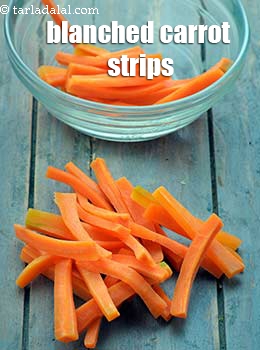
Boil the carrot strips in enough salted water for 8 to 10 minutes. Drain and pour cold water over the strips to stop the cooking process. Use as required.
Carrot cubes
.jpg)
In order to make carrot cubes, firstly peel the carrot and discard the stem. Place on a chopping board and cut the peeled carrot into halves from the centre lengthwise. Take each halve and make vertical slits lengthwise. Combine all the vertical slits together and make horizontal slits breadth wise to get cubes. You can make fine slits or thick slits as per recipe requirements. Carrot cubes are used mainly in subzis, curries and gravies.
Carrot juliennes
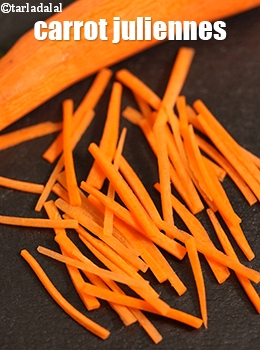
Begin with a clean and peeled carrot. Remove the stem and discard it. Slice four sides of the carrot to create a rectangle. Cut squared carrots into sections that are the desired length of the finished carrot juliennes. Cut each section of carrot lengthwise into approximately 1/8 inch thick slices. Stack the 1/8 inch slices and again, cut lengthwise at approximately 1/8-inch to form the julienne carrot strips.
Carrot roundels
.jpg)
Place a peeled carrot with its stem removed on a chopping board and using a sharp knife, cut at regular intervals across the length of the carrot into thick round slices. Carrot roundels are thicker than sliced carrots and can be used in subzis, curries, stir-fries, soups etc.
Carrot strips
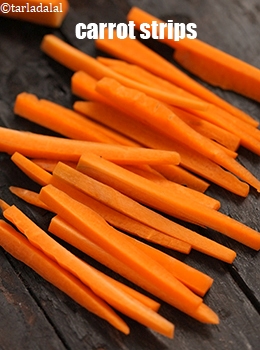
For thick and long carrot strips, peel a carrot and cut into half lengthwise. Place one half of the carrot on a chopping board and cut vertically at right angle to make 1" thick strips lengthwise. Repeat the same to make more strips as per the recipe requirement. Depending on the size of the carrot, you can make approx. 5 to 6 strips from one carrot. Use as required.
Chopped and boiled carrots

Wash the carrots thoroughly, cut off both ends and then peel it. Chop it roughly or finely as per the recipe requirement. Boil enough water in a saucepan and add a little salt to it. Boil it for 10 minutes or till they are soft, then drain off the water. To retain the colour of the carrot you can add a pinch of soda to the boiling water and after boiling immerse it in cold water for maximum freshness.
Chopped carrot
.jpg)
Take a sharp knife, slice the carrot from the top to remove the stem and discard the stem. Place on a chopping board and cut the peeled carrot into halves from the centre lengthwise. Take each halve and make vertical slits lengthwise, approximately ¼ inch in diameter, although the chopped food doesn't need to be exactly the same size. Combine all the vertical slits together and make horizontal slits breadth wise, approximately ¼ inch in diameter, to get chopped carrots. If the recipe calls for the ingredients to be "coarsely chopped," make the pieces slightly larger and if the recipe calls for "finely chopped" make smaller pieces.
Diagonally cut carrot
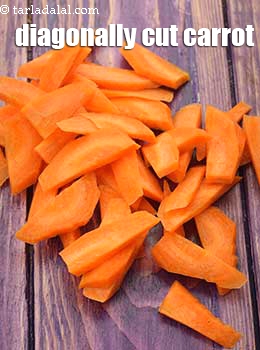
To get diagonally cut carrots, first place a peeled and clean carrot on a chopping board. Cut and discard the corners and using a sharp knife and then cut the carrot into 2 halves vertically. Place one half on a chopping board and using a sharp knife, make series of vertical cuts. You can cut into thick or thin slices as per the recipe requirement.
Grated carrot
.jpg)
Carrots can be grated by a hand grater or a food processor. To grate the carrots with hand, peel them using a peeler. Hold the grater in one hand and the carrot in the other hand. Now place the carrot on the blade (of desired thickness of the holes) and push it downwards using the force of your hands to get grated strands of carrots. Be careful to keep hands and fingers away from the grater. Throw the end of carrot away when it cannot be held on to securely while grating. Grated carrots add colour, flavour, and nutrition to the food it is added to. They are used in salads, soups, sauces, and baked dishes.
Parboiled carrot cubes

To parboil carrot cubes, boil enough water in a deep pan, add a little salt. Add the carrot cubes and cover and cook for 5 to 7 minutes or till the cubes are slightly soft, taking care not to overcook them. Drain, cool and use as required. Parboiled carrot cubes are best suitable for use in baked dishes, stir-fries and many other dishes.
Parboiled carrot roundels

To parboil carrot roundels, boil enough water in a deep pan, add a little salt. Add the carrot roundels and cover and cook for 2-3 minutes or till the roundels are slightly soft, taking care not to overcook them. Drain, cool and use as required. Parboiled carrot roundels are best suitable for use in soups, stir-fries and many other dishes.
Sliced and blanched carrots
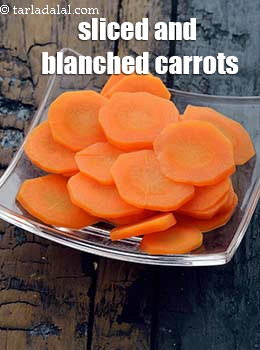
Slice the carrots and boil them in enough salted water for 8 to 10 minutes. Drain and pour the water to stop the cooking process. Use in recipes like sabzis and rice.
Sliced carrots

Wash the carrots thoroughly and peel them using a peeler. Place a peeled carrot with its stem removed on a chopping board and using a sharp knife, cut at regular intervals across the length of the carrot to get thick or thin, round or oval shaped slices.
Also Known as
Gajar, Gajjar
How to select Carrots, Gajar? Carrot roots should be firm, smooth, relatively straight and bright in color. The deeper the orange-color, the more beta-carotene is present in the carrot. Avoid carrots that are excessively cracked or forked as well as those that are limp or rubbery. In addition, if the carrots do not have their tops attached, look at the stem end and ensure that it is not darkly colored as this is also a sign of age.
10 Culinary Uses of Carrot, Gajar.
1. Carrots are delicious eaten raw. Enjoy plain healthy homemade carrot juice for those who are advised to be on clear liquid diet by the doctors. It can be accompiagned with other fruits or vegetables too. Just experience the fabulous taste of Lemony Tomato orange carrot juice, Carrot spinach parsley juice, Beet apple carrot juice.
2. Also you can cook & eat, but cooking carrots will bring out their natural sweetness. Take care not to overcook carrots, however, to ensure that they retain their maximum flavour and nutritional content.
3. Carrot, Gajar ka Halwa is the most popular and mouth-watering Sweet dish. Feel the unforgotten sweet delicacy of Carrot halwa with crepes and rabadi.
4. Enhance the naturally sweet flavor of carrots by adding a little honey or sugar when cooking to make Stuffed Carrot Halwa.
5. Carrots that have become limp can be soaked in ice water to make them crisp again.
6. Carve carrots into beautiful garnishes or add them to soups. Easy to pack and perfect for the favorite dip, the crunchy texture and sweet taste of carrots is popular among both adults and children. Click on to check soups made with carrot.
7. Shredded raw carrots and chopped carrot greens make great additions to salads.
8. For quick, nutritious soup that can be served hot or cold, purée boiled carrots and tomatoes in a blender and add herbs and spices to taste. Try our Cream of Carrot Soup.
9. Spiced carrot sticks carrot pickle are a flavourful variation on an old favorite at parties or at the dinner table. Soak carrot sticks in hot water spiced with cayenne, coriander seeds and salt. Allow to cool, drain and serve.
10. Combine carrot and coriander to make a heart friendly Carrot Coriander Juice for breakfast. Its juice is one of the most delicious and healthful, and alone or in combinations.
How to store Carrots, Gajar?Carrots are hardy vegetables that will keep longer than many others if stored properly. The trick to preserving the freshness of carrot roots is to minimize the amount of moisture they lose. To do this, make sure to store them in the coolest part of the refrigerator in a plastic bag or wrapped in a paper towel.
Health Benefits of Carrots, Gajar. 1. Keeps your Eyes healthy : Carrots have the nutrient Beta Carotene which is a form of Vitamin A, helps prevent detonation of the eye as one gets older and prevents night blindness. Sadly in India, poor rural families who don't get enough Vegetables like carrots have high incidence of blindness. This is easily preventable.
2. Lowers Cholesterol : Since its a good source of Fibre, it tends to lower the bad cholesterol in your body.
3. Lowers Blood Pressure : Carrots have good Fibre which reduces plaque formation resulting in the blood flowing smoothly in your arteries. Result will be a steady flow of blood through your system.
4. Rich Antioxidant : Carrots have Beta Carotene which is a powerful Antioxidant . It helps fight free radicals which do damage to our cells. The net result is lower body inflammation.
5. Reduces Cancer Risk: Beta Carotene present in Carrots is linked to reduce cancer.
6. Good source of Vitamin C : About 1 cup of Carrots provide 12% of your recommended daily allowance of Vitamin C. The Vitamin C enables your body to process WBC (white blood cells) provided you have the correct amount each day. This will boost your immunity.
7. Good for Diabetics : Since it has a low glycemic load, Carrots will not raise your blood sugar rapidly. Also their Carotene helps prevent degeneration of the eyes through Diabetes. Eat carrots in moderation for Diabetics .
Glycemic Index of Carrots, Gajar. Carrot has a Glycemic Index of 71 which is high. Glycemic Index are for foods you eat, ranks carbohydrate-containing foods by how quickly they digest and raise your blood sugar or glucose levels. Foods rank from 0 to 50 are low GI, 51 to 69 are medium and 70 to 100 are high. Foods that are high in GI are not suitable for weight loss and diabetics. Foods like Carrots have a high GI but low Glycemic load and hence can be eaten in moderation by Diabetics.